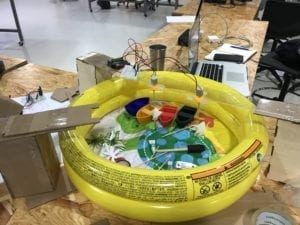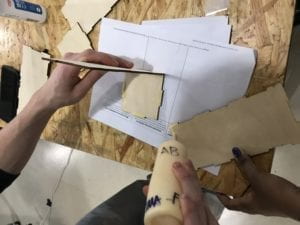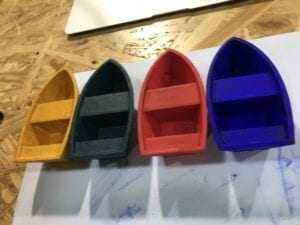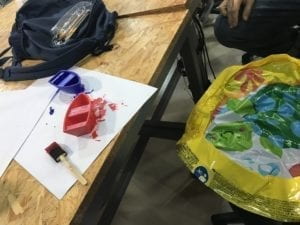For our Final Project we decided to improve upon Pirate Chase (our midterm project) and create a new and improved version of our game! Pirate Chase 2.0 is a boat racing game which requires two or more players to blow on their boats to reach the Treasure Chest. Players are allowed to blow on the other participants boats and must avoid letting their boats sink. In the Final Project, we included a few moving obstacles to make the game even harder. We gave our game a Pirate theme because we wanted to see how competitive the participants would get when trying to capture the treasure. We got our inspiration for this from the Economic Theory of the Tragedy of the Commons and wanted to analyze how far individuals would go to push their opponents away from reaching the treasure. In thinking about how our participants would interact with our project, we decided to use a round baby pool (60cmx30cm) as our “ocean” instead of the original rectangular shaped box, as we thought it would be more interactive if individuals could move freely around the circle, without being constrained by the four corners of a box. We also incorporated Processing into our game, by setting up a countdown as well as graphics to display when players should start the game and when a player wins the game. We also downloaded the Sound and Minim library to help us play the Pirates of the Caribbean theme song.


We included two obstacles, namely wave-making machines that produced waves in the water making it harder for individuals to blow on their boats directly towards the treasure. We also painted our boats blue, red, green and yellow to improve the design of our previous boats and make it more clear to users as to which boat belonged to which participant. We 3D printed wider boats as people had been complaining earlier that the boats sunk really fast. We also still used the infrared sensor to detective when the boats reached the treasure chest. We thought of using the color sensor to detect which boat won and customize the screen to show the winner but unfortunately we were not able to implement this fully.


The production process involved a lot of work but we had a fun time throughout the entire process. We 3D printed four new boats and painted them in different colors. We also laser cut two boxes to support our “bridge” on which we would place our obstacles. Initially we had planned to place the treasure chest and infrared sensor on the bridge as well but we found that the pool was too small and the game would end sooner than we expected. We therefore fixed the infrared sensor and treasure chest separately on one end of the pool and the obstacles in the middle of the pool to make it harder for participants to reach the treasure. During the user-testing session, we were told that the users could not see the screen and play the game at the same time because we had placed the laptop screen on the side. We therefore had the screen lifted up and placed it right behind the treasure chest so that the participants could clearly see when the timer had gone off and when they had won the treasure. We were also told to hide the arduino and breadboard as it was pretty distracting. One thing we had to keep in mind was the obstacles falling into the water. Using water and electronics together was quite scary but we were able to pull it off in the end. At the end of the day, our ultimate aim was to see how competitive the users would get over non-existent treasure, and it worked just as we had assumed. People became more competitive when they were told there was an end goal to meet. Applying this to the Tragedy of Commons theory, individuals will be more likely to compete and drive their opponents away in an attempt to achieve limited resources, and in our case this was the treasure chest.
In conclusion, the main aim of our project was to showcase the “Tragedy of the Commons” concept (which was first introduced by American ecologist Garrett Hardin) through a fun and interactive game. Through the game we hoped to see how participants would react in a situation where there exists limited resources in a specific area, and in our case it was the treasure chest. Most importantly, we wanted our project to be as interactive as possible. Referring back to my definition of interaction, I stated that I had originally seen interaction as a form of communication, however I added to this definition stating that it is not only a form of communication, but also a way of blending technology and human abilities together in the most natural way without undervaluing the capabilities of humans, to therefore fulfill a greater aim. By allowing students to blow on the boats, I hoped to show how important human interaction was in using electronics.
The participants who took part in the game loved the idea of blowing on the boats and said they had a lot of fun competing against their friends. If we had more time, we would get a bigger pool, so that all four boats could be used in the game instead of two. We would also include stable obstacles such as shark fins to make the game even harder. With respect to the Processing side of things, we would add more audio/visuals to show who won, perhaps by including the sound of coins to represent treasure. We had to keep revising our project, making sure our boats floated as our first ones had not, and by merging both human interaction and computer interaction, our project in the end aimed to show these two things can work together in harmony. Bret Victor encourages us to not restrict interaction to the use of a single finger on a touch screen which is why we decided to incorporate “blowing” and physical movement in our project. This therefore allows individuals to truly feel as though they are not being undervalued, with the computer doing all the work, but rather sets an equal balance between man and machine. Ultimately, by the end of the class I have learnt what interaction truly means and how we can incorporate both human interaction and computer interaction into a project to help users learn something useful while also having fun. (Find below a video of our Project during the IMA End Of Semester Show).